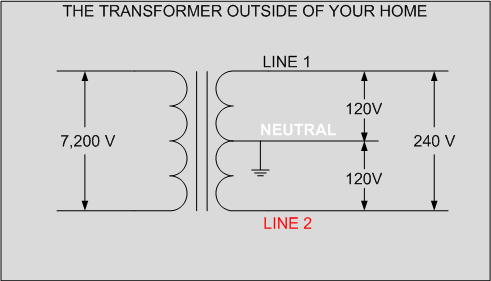Most homes in the U.S. are fed by what is called a split phase transformer. Without going too much into the details, you end up with three wires coming in from the transformer, one from one end of the transformer, one from the other end of the transformer, and a third connected to the middle of the transformer coil (hence, “split” phase). The one connected to the middle of the transformer is your “neutral” wire and is connected to earth ground. Literally. As in it’s typically connected to a copper round that is pounded into the ground. The wires connected to either end of the transformer coil are your two “hot” wires.
If you measure between either “hot” wire and neutral, you get 120 volts. If you measure between the two “hots”, you get 240 volts. Hopefully this diagram will help to explain it. The diagram shows the distribution voltage as 7200 volts, but this varies. Anywhere between about 3500 volts and 12,000 volts is typical.

If you look at your breaker box, the breaker slots alternate between the two “hot” wires. In other words, if you go down the left side of the breakers, the first slot is connected to Line 1, the second slot is connected to Line 2, the third slot to Line 1, the fourth slot to Line 2, etc. If you have a 120 volt circuit, then the breaker only connects to one of the two hot lines. If you have a 240 volt circuit, that breaker is double-wide, and connects to two adjacent slots so that it gets the entire voltage between line 1 and 2 (240 volts).
This diagram shows a single breaker at the top and a double (240 V) breaker wired to a dryer at the bottom.

So your 240 volt circuits (dryer, oven…) will get connected to both Line 1 and Line 2. All of your 120 volt circuits should be roughly balanced, with half of them connected to Line 1 and half of them connected to Line 2.
If you have a bad connection on say Line 2, but no problem with Line 1, then all of the stuff connected only to Line 2 will flicker, but stuff connected to Line 1 will not. The problem could be at the transformer, at the electric meter, or at the breaker box. If it is truly only one circuit that is flickering, and not the entire Line 1 or Line 2, then it could be a bad connection at that breaker or it could be a failing breaker.
Another type of problem that you can have is if the neutral (aka center tap) connection to the home’s transformer has a bad connection. This can be really bad, because you will still have 240 volts between Line 1 and Line 2, but the neutral will tend to float between the two voltages. So if the voltage between Line 1 and neutral floats down to only 80 volts, Line 2 floats up to 160 volts (240 - 80 = 160, the total will always add up to 240). Obviously 160 volts is bad for devices designed to operate on 120 volts, so this type of failure can cause a lot of damage to lights, appliances, etc.
A broken neutral should be easy to identify. If you measure the voltages coming into the breaker box, you’ll see that Line 1 and Line 2 aren’t balanced. Any competent electrician should be able to test for that.
Distribution wires (the wires that go all around your neighborhood) often are not insulated. They are designed to get wet. No biggie. The wires that go from the transformer to your home typically are insulated, but if they have a bad spot on the insulation and get wet that won’t cause the symptoms that you are seeing. Snow and ice between wires can cause issues.
He’s right. It’s a good idea to have them check the wires.
One good thing that you can try yourself is to flip the breakers on and off, one by one. If you turn one specific breaker off and all of the lights that were flicking go off all at once, then you know that your problem was only on that circuit. Have your electrician look at that circuit. If one and only one breaker does not control all of the lights that were flickering, then the problem isn’t just one circuit or breaker, and may be outside your home.


